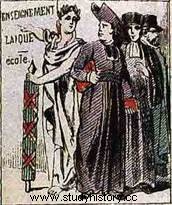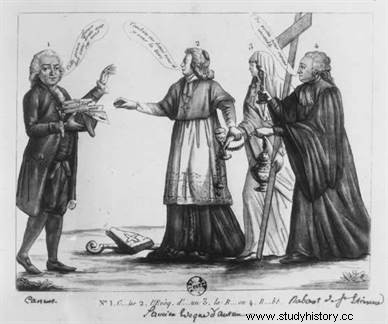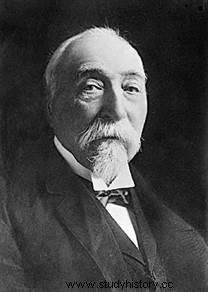 The Law of Separation of Church and State of December 9, 1905 put an end to the Concordat regime of 1801 which associated the Catholic Church and the State in France. Anchored in the republican tradition, the idea of a separation of the Catholic Church and the French State was already pronounced by the revolutionaries on February 21, 1795. During the 19th century, a long process of secularization of society and the State is set up, to lead to the vote of the law of 1905. Looking back on the history of this decisive law can help us in part to understand this philosophical and political principle so difficult to define, but today constitutional, guarantor of republican equality.
The Law of Separation of Church and State of December 9, 1905 put an end to the Concordat regime of 1801 which associated the Catholic Church and the State in France. Anchored in the republican tradition, the idea of a separation of the Catholic Church and the French State was already pronounced by the revolutionaries on February 21, 1795. During the 19th century, a long process of secularization of society and the State is set up, to lead to the vote of the law of 1905. Looking back on the history of this decisive law can help us in part to understand this philosophical and political principle so difficult to define, but today constitutional, guarantor of republican equality.
The first separation of Church and State (1795)
 Without going back here to the deepest origins of secularism (which take us long before the Enlightenment), we must Dwell on an often overlooked fact, the first law of separation between Church and State, which appears in the Constitution of Year III (1795):"No one may be prevented from exercising, by conforming to the laws, the worship he has chosen. No one may be forced to contribute to the expenses of a cult. The Republic does not employ or subsidize any of them”.
Without going back here to the deepest origins of secularism (which take us long before the Enlightenment), we must Dwell on an often overlooked fact, the first law of separation between Church and State, which appears in the Constitution of Year III (1795):"No one may be prevented from exercising, by conforming to the laws, the worship he has chosen. No one may be forced to contribute to the expenses of a cult. The Republic does not employ or subsidize any of them”.
The context is obviously that of the Revolution, and even more of great tension in France partly due to the Civil Constitution of the Clergy (1790), but also to the role of part of the Church in the counter-revolution and its weight has become suffocating for society. France experienced a period of great anticlerical violence, dechristianization, which culminated in the years 1793-1794. The decision of 1795, supposed to ease tensions, did not really succeed and the attempt to secularize the State ended in 1801, with the Concordat signed between Bonaparte and the Catholic Church...
A first secular republican stage:school (1882)
During the 19th century, when the concordaire statute of 1801 concluded with the Holy See governing the status of the French Church, a long process of secularization of society and state is set up. In 1830, the Catholic Lamennais himself called for separation in the name of religious freedom:“We Catholics demand the total separation of Church and State. »
Relations between Church and State continued to be tense throughout the 19th century, and the advent of the Republic did not help matters, especially since the Republicans have not abandoned the idea of secularism, on the contrary. Secularization begins with the law of 1880, which abolishes Sunday rest, or with the legalization of divorce in 1884. But it is above all the school, where the citizen must be built and where equality is supposed to be ensured. , which becomes secular.
The law of March 28, 1882 imposes, among other things, the neutrality of public schools and the abandonment of religious education (authorized on the day of rest, outside school):secular morality, the universality of republican values, the teaching of the rights and duties of citizens, replace the catechism. The teachers become the famous "black hussars of the Republic".
The context of the Third Republic (1890-1904)
Obviously, not everything went smoothly, resistance was fierce, even in Rome (despite the election of Leo XIII, who was more conciliatory). Then, the situation calms down a little, with Republicans who, for some, are satisfied with the Concordat. It seems that it is, in part in any case, the Dreyfus affair which revives the tensions. The Church sees in this state affair a plot by Protestants, Jews and Freemasons; she relies in her campaign on newspapers like "La Croix" or "Le Pèlerin", and shows that she still has real power.
 It was in this climate that the left won the legislative elections of 1898. The law on associations of 1
er
July 1901 was partly intended to control the congregations by imposing an authorization from Parliament. The state now limits the freedom of congregations by requiring the transparency of their finances; for, if the congregations are accused of being rich, they are also accused of having an anti-republican influence on the youth they educate.
It was in this climate that the left won the legislative elections of 1898. The law on associations of 1
er
July 1901 was partly intended to control the congregations by imposing an authorization from Parliament. The state now limits the freedom of congregations by requiring the transparency of their finances; for, if the congregations are accused of being rich, they are also accused of having an anti-republican influence on the youth they educate.
The new victory of 1902 allows Emile Combes to conduct a resolutely anticlerical policy this time, attacking mainly the congregations, which provokes the anger of Pope Pius X. But Combes is not yet for a real separation. It was undoubtedly precisely the Pope's intransigence, which went so far as to break off diplomatic relations with France, which pushed Combes to resolve to separate in 1904.
Church and State Separation Act 1905
However, it is not to Emile Combes that we owe the law of separation of Church and State. He was indeed forced to resign in January 1905, following the “fiche des fiches” affair. However, it partly influenced the work that followed, up to the drafting of the law. However, this stems mainly from the report of the Parliamentary Commission chaired by François Buisson, who is also at the head of the National Association of Freethinkers and the Education League. The other important craftsman is the rapporteur of this Commission, a certain Aristide Briand. This one advocates a law of pacification, and he has a hard time convincing, both Catholics and the most radical Republicans.
 The debates last from April to July 1905, the law of separation of Church and State is passed on December 9, 1905. Several major principles underlie it:it affirms the reciprocal independence of the State and the Church - the Republic guarantees the free exercise of worship and freedom of conscience (mainly Articles 1 and 2); the State prohibits any interference in religious matters and does not subsidize any religion (Article 4); however, freedom of worship is exercised with respect for public order and individuals (Article 5). The 1905 law also allows the State to recover Church property, now managed by secular religious associations. It is a "fair and wise" law according to Jean Jaurès.
The debates last from April to July 1905, the law of separation of Church and State is passed on December 9, 1905. Several major principles underlie it:it affirms the reciprocal independence of the State and the Church - the Republic guarantees the free exercise of worship and freedom of conscience (mainly Articles 1 and 2); the State prohibits any interference in religious matters and does not subsidize any religion (Article 4); however, freedom of worship is exercised with respect for public order and individuals (Article 5). The 1905 law also allows the State to recover Church property, now managed by secular religious associations. It is a "fair and wise" law according to Jean Jaurès.
However, the law is very badly received by the Catholic Church. As soon as the law was promulgated, tensions exploded, in particular around the inventories of ecclesiastical property. The pope condemns it. These struggles, sometimes violent, lasted even after the Second World War, and it was not until the end of the 1950s and the beginning of the 1960s that it seemed that secularism was finally accepted by all. It became a constitutional principle at the beginning of the Fifth Republic (1958), and the Second Vatican Council allowed real peace between the Republic and the Church.
Today, however, it would seem that secularism, and in particular its legislative translation of 1905 (and soon of 1882?), is once again being challenged. But that's no longer history...
Bibliography
- H. Pena-Ruiz, What is secularism?, Folio, 2009.
- J. Lalouette, The State and Cults (1789-1905-2005), La Découverte, 2005.
- R. Rémond, The invention of secularism (from 1789 to tomorrow), Bayard, 2005.
- J. Baubérot, History of secularism in France, PUF, 2010.
